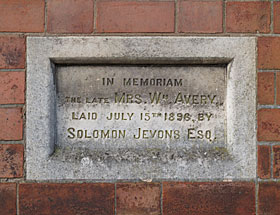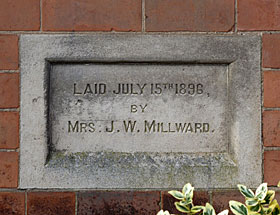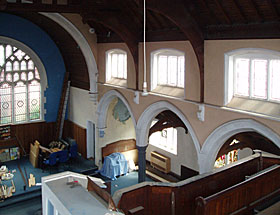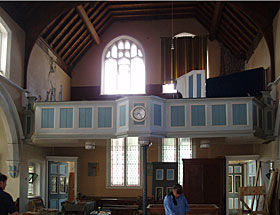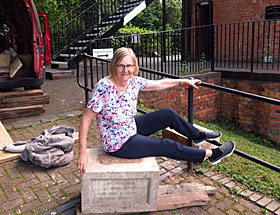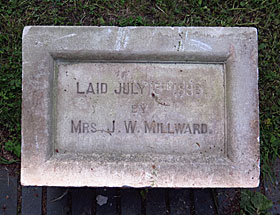History of the Wesleyan Methodist Church in Headless Cross
Introduction
William Avery was a prominent member of the Wesleyan Methodist church in Headless Cross. Therefore, the history of this church may be of interest to individuals who own, collect or are interested in Avery style needle cases. This history includes detailed information found in a time capsule placed under a memorial stone dedicated to Mr. Avery' wife when the church was constructed in 1896. The time capsule was uncovered a hundred and twenty years later during the church's demolition in 2016. Additional details about what the area was like in 2012 and 2017, when I personally visited Headless Cross, are included as is what I discovered there.
A special thank you goes to Peter Harris of the Redditch area for sharing his photographs of the time capsule contents, the interior of the church and of the church during demolition. Also I'd like to thank Raymond McLaren of Headless Cross for taking me to so many interesting places during my visit and to Jo-Ann Gloger and Ches from the Forge Mill Needle Museum for helping preserve a piece of history related to Mr. Avery.
This section is divided into five sections to make it easier to read.
The sections are:
Church History
My Visits to the Church Site and What I Discovered
Time Capsule Contents
Photographs
Bibliographic Notes

Photograph taken October 3, 2012
Church History
In 1827 the first Wesley chapel was erected in Headless Cross. Although it was enlarged in 1858, a new chapel was built on the site in 1873 to meet the needs of a growing congregation. The building was opened on February 23, 1874 Approximately twenty-one years later on December 2, 1894 special morning and evening services were held to celebrate the 50th anniversary of William Avery’s service as the organist.
On Sunday March 25, 1895 a cyclonic gale, struck the northwest coast of England, and traveled in a north easterly direction, sweeping over the Midland counties. At 9 a.m. the barometric pressure at Redditch suddenly sunk half- an-inch and read 29.051 in. The temperature in the sun and shade also fell, both about 10 degrees F. During the morning there were a few slight gusts of wind which suddenly by 12:30 p.m. developed into a violent gale which lasted until 2 p.m. Numerous minor causalities occurred in the town of Redditch and the neighboring area. At about 1:15 p.m., while the gale was at its peak, the pressure was about 37 lbs. on the square inch and the velocity about 50 miles per hour, the chapel was much affected by the wind. Suddenly at 1:20 p.m. a loud crack was heard coming from the building and the roof and gables fell in, followed by the projection of the whole of the east wall forward into and across the public road. The caretaker had only exited the building ten minutes before its collapse. Fortunately, no one was in the building at the time and no lives were lost by the accident.
Almost immediately after this unprecedented destruction of the chapel by the gale, a committee was formed and steps were taken to replace the chapel with a better building. A new church was constructed on the site at an estimated cost of £2,499. The architect was Mr. E. Harper of Barnt Green and the contractors were Messrs. Surmon and Son from Redditch. On July 15, 1896 four memorial stones were laid, by Mrs. J. Harry Harper, Mrs. Florence Allcock, Mrs. Millward, and special one by Mr. Solomon Jevans of Birmingham for Maria Proctor Avery, the wife of William Avery J. P., who entered into rest June 14, 1895 at age 63. For forty years Mrs. Avery was known for her Christian devotion to the welfare of the poor, the sick and the suffering in the village. A time capsule was laid beneath the memorial stone to Mrs. William Avery which contained notes and papers with other information of local interest. On the completion of the building Mr. William Avery had a new organ erected as a memorial to his late wife.
The church remained in use for many years and served the community well. However, roughly 110 years after its construction, the chapel was in need of costly structural repairs and sometime around 2009 was closed to the public due to the hazardous conditions inside. On Ash Wednesday, February 25, 2009, the Headless Cross Methodist Church was joined together with St. Luke’s church which was located approximately half a mile north on Evesham Road in Headless Cross This became an Ecumenical Church called The Bridge and services were thereafter held at the St. Luke's site.
When the community was unable to raise enough funds to restore the building, Peter Harris photographed the interior of the church before the property was sold . Then in 2016 the church building was torn down to make way for new townhouses and again Peter was able to photograph its demolition, a sad event.
My Visits to the Church Site and What I Discovered
When I first visited the Redditch area in October 2012 the Wesleyan Methodist church in Headless Cross was still standing. What impressed me most was the elaborate bell tower on the church’s southeast corner. Although I was unable to enter the building, since it was closed to the public, I stood for a few minutes in the entrance vestibule and visualize what it must have been like for William Avery when he entered the building over 100 years earlier. As I walked around the front of the building I noticed the memorial stones and was pleasantly surprised to find the one dedicated to Mr. Avery’s wife. I knew from his obituary and other research that Avery was a prominent member of the church and that he helped raise funds for the new church when it was built in 1896. However, it wasn’t until my visit that I learned about the memorial stone to Mrs. Avery.
Fast forward five years. What a shock I had when I returned to the Redditch area in 2017 and learned that the church was demolished and in its place a row of townhouses was currently being built. On my second day in the area, after lunch at “The Gate Hangs Well” pub a few blocks away, I walked to the church site while my friend Raymond McLaren, who was showing me around, parked his car. When I walked past the construction site I saw one of the workman cross the street to retrieve something from his vehicle. As a typical American I started to talk to him and within a few minutes asked if he knew anything about the church that used to be located there. His supervisor saw me and motioned for us to come to the back of the construction site. Once there I asked him if he knew anything about what happened to the old church’s memorial stones. Then he pointed to an area inside the construction site and when I glanced in the direction of his hand I saw three of the stones. I immediately asked what they were going to do with them and he responded that they had been waiting over a year for someone to pick them up. He added that if that didn’t happen soon, the stones would most likely be discarded with other used construction materials. I quickly suggested that perhaps the Forge Mill Needle Museum would be interested in them. I informed the workmen that I would be meeting with museum staff the next day and asked if they would be willing to release the stones to the museum if we could figure out a way to retrieve them. They replied “of course”.
The next day I explained what happened at the construction site to Jo-Ann Gloger, Keep of Collections at the museum and she agreed that the stones needed to be saved. While I visited the museum, Jo and her assistant Ches drove to the construction site and with the help of the construction workers loaded the three stones into Ches’s van and brought them to the museum. After considerable effort they were unloaded and placed along the walkway on the east side of the museum, their new home. For me I felt proud to have played a role in preserving a part of William Avery’s history.
Time Capsule Contents
When the church was demolished in 2016 the time capsule was found and Peter Harris photographed the contents. The following items were not only included in the time capsule, but were referenced in a 1896 note made by Herbert Page M.D. of Redditch, which was included in the capsule, to document its contains.
- Local Notes and Synopsis of the Progreess of Wesleyanism at Headless Cross
- Photograph of the Ruins of the Chapel in 1873
- Sample of Wall and Hand Bills of todays Ceremony
- Public Appeal in aid of the New Church
- Appeal and Form for Subscription
- Welseyan Methodist Circuit Plan for the Year 1896
- Architect's Description of the New Church, Sketch Plan of the Ground Floor and Copy of the wood block of the Elevation
- Copy of "Sketch of Wesleyan Methodism in Redditch 1752-1892" by Rev. Alfred Tucker (late Minister)
- Copy of Local Almanac and Directory for 1896
- Copy of "Indicator" Newspaper for March 30th, 1895 containing account of the great Gale and the destruction of the Chapel
- Copy of the last issue of the "Indicator: for July 11th, 1896
- Copy of "Methodist Recorder" for July 9th, 1896
- Copy of "Methodist Times" for July 9th, 1896
- Copy of "Old Redditch" by Mr. William Avery J.P.
- Copy of this day's "Birmingham Daily Post" July 15, 1896
- Copy of this day's "Birmingham Daily Gazette" July 15th 1896
- A few samples of Needles, Fish-Hooks and Pins made at Headless Cross
PDF files were created from Peter's photographs for two of these documents which can be downloaded here.
- Old Redditch Being an Early History of the Town by William Avery – PDF.
NOTE: the last page of this booklet contains a handwritten note by Herbert Page in 1896 regarding lectures Mr. Avery gave regarding the history of the town. - Sketch of Wesleyan Methodism in Redditch – PDF
Photographs
37 photographs related to the Wesleyan Methodist Church in Headless Cross are displayed below. Click on each photo to see a larger version of it. All photographs, unless otherwise noted, were taken by Terry Meinke during her 2012 and 2017 trips to the Redditch area. Peter Harris provided the photographs of the interior of the church, the time capsule contents and the church's demolition in 2016.
This photograph and drawing of the 1873/74 Wesleyan chapel after it was destroyed by the cyclon in 1894 was included in the time capsule (from Peter Harris)
Photograph of one of the plaques placed on the original chapel in 1874 and a drawing of the new church built in 1895/96 (from Peter Harris). William Avery's wife was Maria Proctor Dingley whose father and brothers were Wesleyan Methodist preachers from Sherborne. It seems most likely that Mrs. A. Dingley was Mrs. Avery's grandmother.
Items found in the time capsule placed in 1896 under the memorial stone to Mrs. William Avery (time capsule photo from Peter Harris, Avery memorial stone photographed in October 2012). Mr. Solomon Jevons Esq. (1825-1904), a promeninet member of the Wesleyan Methodist church in Birmingham and a retired thimble maker and haberdasher, was responsible for Mrs. Avery's stone. Jevons was best known in Birmingham for having donated c10,000 to help build an orphanage there.
Views of the church taken in October 2012.
Views of the church and the memorial stone laid by Mrs. Millward, photographed in October 2012.
Views of the memorial stones laid by Mrs. Harper and Mrs. Allcock, photographed in October 2012.
View of the stained glass window from the exterior taken in 2012 and from the interior (interior photo from Peter Harris).
Interior views of the church (from Peter Harris).
Interior views of the church (from Peter Harris).
Interior views of the church (from Peter Harris).
Interior view of another stain glassed window in the church and the exterior of the church during demolition in 2016 (from Peter Harris).
The church during demolition in 2016 (from Peter Harris).
The church during demolition in 2016 (from Peter Harris) and the construction of townhouses in its place in May 2017.
Two of the construction workers and the memorial stone to Mrs. Avery in the construction site in May 2017.
Three of the memorial stones arrived at the Forge Mill Needle Museum in May 2017 the day after Terry discovered them at the construction site. Terry celebrated their arrival by posing on Mrs. Avery's stone.
Jo-Ann Gloger, Ches and other museum staff unloading and positioning the stones near a museum walkway in May 2017.
The memorial stone for Mrs. Wm. Avery and the stone laid by Mrs. Millward photographed at the museum in May 2017.
The memorial stone laid by Mrs. Harper at the museum and the exterior of the Primitive Methodist Church on the corner of Chapel Street and Birchfield Road in Headless Cross, built in 1867 and photographed in May 2017.
The Episcopal Church of St. Luke's in Headless Cross, built in 1843 and photographed in May 2017.
Bibilographic Notes
The information about Mr. Solomon Jevons came from the following sources:
1) The Wesleyan Missionary Notices, Relating Principally to the Foreign Missions under the Direction of the Methodist Conference , Fourth Series, Vol VIII, 1876. Page 202
mentions Solomon Jevons as the late treasurer of the Birmingham District who gave a private breakfast in order to raise funds for the church. (Available on Google Books).
2) The Christian Advocate , December 15, 1904, page 2037. Lists a short obituary indicating Soloman Jevons was a millionaire who gave £10,000 to Princess Alice
Orphanage. (Available on Google Books).
3) Ancestry.com which included geneaological details about his birth, marraige, children and death. Additional, the census records and trade journals on ancestry.com show that
Jevons was a thimble maker and a haberdasher from Birmingham who retired between 1871 and 1881.










